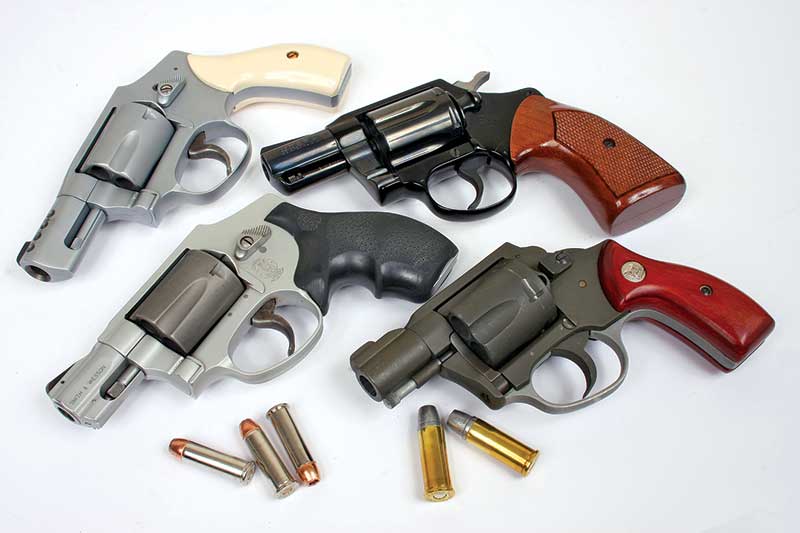An Expert’s Gun
Yeah, I know, we all have one or more of them, and there’s nothing wrong with that. In experienced hands — and I mean near-expert hands — they are effective, accurate, reliable and highly concealable. But frankly, too many inexperienced shooters have them, and in most of their hands, the small revolver is an inadequate tool with the potential for being a real problem if called upon to be used.
It’s been my experience most who carry a small-frame revolver can’t shoot it worth beans, and hardly ever (maybe never?) shoot it anyway. In their mind’s eye they have themselves whipping it out, engaging a bad guy, the bad guys does down with solid, centered hits, and the good guy is a hero.
In reality most people shoot poorly with these little guns, don’t carry a reload, can’t manipulate them well and have little or no idea of the gun’s true abilities. They’re a potential danger to themselves and everyone around them.
Why do we seem to think we can buy one of these guns, load it, and for some magical reason — suddenly know everything about it?

A S&W 6" Model 14 and a 5-screw 36 on the right. At a lasered
37 yards (I liked the shady spot for the target …), using Federal
.38 Special148 gr. Match wadcutters the 14 gave 2.25" and the 36
about 3.6". Not bragging — just showing the little guns can shoot
if you know what you’re doing. Astoundingly enough, the J-frame
was spot-on (a rarity) and I favored the top of the red zone as
shot, dropping the shots right in.
The Problem At Hand
Are small-frame revolvers actually expert’s guns? Absolutely. But, they’re alluring because they’re easy to carry. Few are willing to compromise with comfort, and are drawn to the lightweight and small size of these appealing little shooters. But is that bad?
It’s not — if you take the time to learn to run these tiny terrors. If a gun-store-counter-commando talks you into buying one for your wife or yourself, there’s more to the game than simply loading it and putting it into your pocket. Much more.
Don’t be fooled though — the guns are inherently accurate, and I’ve actually shot old-time PPC courses (a form of police target shooting out to 50 yards) and used a 2.5″ Model 19 .357 K-frame. You’d be stunned at the groups possible at 50 yards, and a tuned gun in good hands can deliver 5″ or 6″ — and better! — easily at that range. The scary thing is so can some J-frames in good hands.
Not long ago at Gunsite, with a crew from S&W, we shot 2″ to 5″ J-frame .38s out to 100 yards, making regular hits on man-sized steel. But these were experienced shooters, and most importantly, everyone knew how to run a double action revolver, staging the trigger to get accuracy at the same level you can get shooting single action. And that’s the biggest secret to these little guns (or any gun) — trigger control.
More Secrets
Like anything small, a J-frame or equivalent can be fumbly so you have to train your fingers to work smaller grips, smaller triggers, harder actions, cylinder releases tending to be sticky and tiny cylinders. Not to mention those usually inadequate sights and short sight radius. But, if you seek the training you should, from people who understand these guns, you’ll find them to be elegant compromises when it comes to personal protection working guns. If you’re willing to work at it.
As we’ve chatted about before in these pages, sight picture is important, but trigger control is paramount. It’s especially true with these little guns, as the slightest wobble can toss a round into the next county. If you gain control over the stagy-hard-gritty trigger on many of these guns, you’ll be rewarded with accuracy sure to surprise you.
When I was a range officer for a short time on the police department, we would have detectives attempt to qualify with their various 2″ guns. This was the very early 1980s and wheelguns were the backbone of police work. Plus, wearing a Colt Detective or Chief’s Special was the hallmark of a detective. Call it their badge of office.
However it was the rare bird who could actually shoot one. Most would show up with their old duty belt and 6″ Model 10 and shoot that. I would cry foul, but at the time, it was allowed. But now and again, I’d see one try with a 2″ and snort in disgust, “This is a piece of crap and it won’t hit a thing at this distance!”
“This distance” was usually seven to 15 yards. “Can I borrow it for a sec?” I’d ask. They’d hand off, making harrumphing noises of disgust. I would load with five and, taking a comfortable stance and staging the trigger, could usually place the five in a neat group in the head or center torso of the B27 target. I would then hand the gun back and say something witty and charming like, “Gosh, the gun seems to shoot fine. Perhaps you need to learn how to shoot it? I’d be happy to teach you,” delivered with a big, toothy grin.
I also bought a lot of small guns, cheap, right then and there, and used to keep a $100 bill in my wallet just for that purpose. And it’s too bad, as 15 minutes of training might have had most of them on-target — if they’d only wanted to learn.
And that’s the key, right there in front of us. You need to want to learn. It’s the only way you’ll be safe with these guns. And, it’s the only way you’ll be able to use one and enjoy just how remarkable these little “expert’s guns” truly are. Honest.





